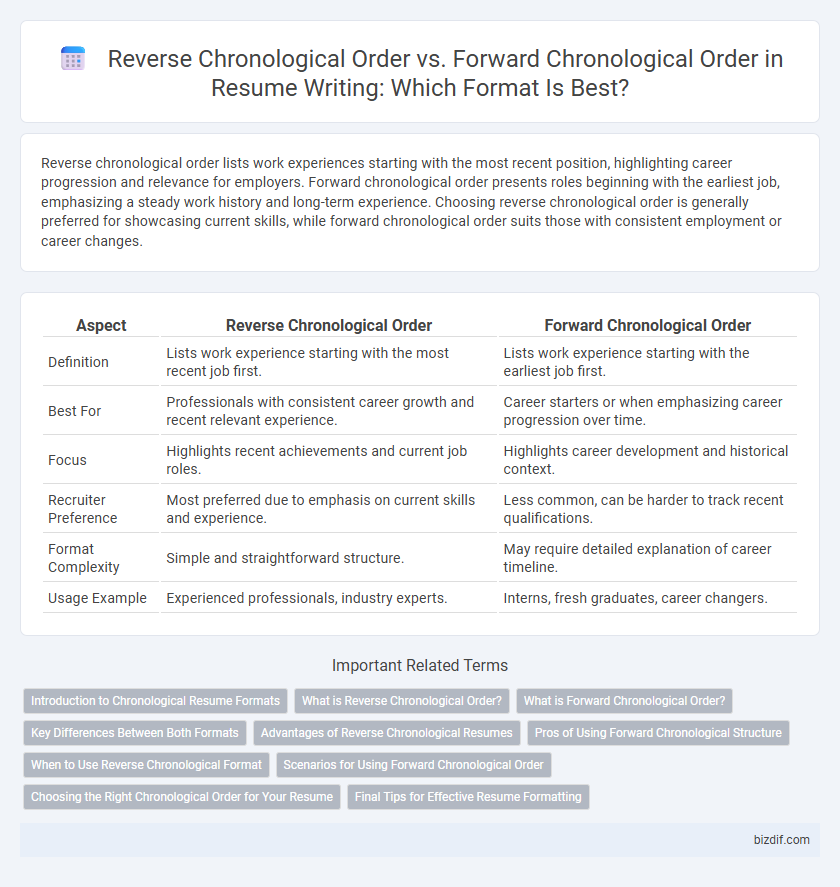Reverse chronological order lists work experiences starting with the most recent position, highlighting career progression and relevance for employers. Forward chronological order presents roles beginning with the earliest job, emphasizing a steady work history and long-term experience. Choosing reverse chronological order is generally preferred for showcasing current skills, while forward chronological order suits those with consistent employment or career changes.
Table of Comparison
| Aspect | Reverse Chronological Order | Forward Chronological Order |
|---|---|---|
| Definition | Lists work experience starting with the most recent job first. | Lists work experience starting with the earliest job first. |
| Best For | Professionals with consistent career growth and recent relevant experience. | Career starters or when emphasizing career progression over time. |
| Focus | Highlights recent achievements and current job roles. | Highlights career development and historical context. |
| Recruiter Preference | Most preferred due to emphasis on current skills and experience. | Less common, can be harder to track recent qualifications. |
| Format Complexity | Simple and straightforward structure. | May require detailed explanation of career timeline. |
| Usage Example | Experienced professionals, industry experts. | Interns, fresh graduates, career changers. |
Introduction to Chronological Resume Formats
Reverse chronological order arranges work experience by listing the most recent job first, highlighting career progression and recent achievements. Forward chronological order begins with the earliest experience, emphasizing long-term career development and consistency. Understanding these chronological resume formats helps tailor resumes to showcase the most relevant information based on career goals and job requirements.
What is Reverse Chronological Order?
Reverse Chronological Order is a resume format that lists work experience starting with the most recent position and progressing backward in time. This structure highlights career progression and recent achievements, making it easier for employers to see the candidate's current skills and relevant experience. It is the most commonly preferred format by hiring managers and is especially effective for candidates with a strong, continuous work history.
What is Forward Chronological Order?
Forward chronological order in resume writing lists work experience starting with the earliest job and progresses to the most recent position. This format highlights career growth over time but may underemphasize recent roles or skills. It is less commonly used than reverse chronological order, which prioritizes the latest experience first to capture employers' immediate attention.
Key Differences Between Both Formats
Reverse chronological order lists work experience starting with the most recent position, highlighting career progression and current skills, making it ideal for professionals with consistent work history. Forward chronological order begins with the earliest job, emphasizing long-term experience and growth over time, which can be useful for entry-level candidates or those with gaps in employment. Key differences include the focus on recent versus older experience and how each format impacts the visibility of career development and relevance to the job applied for.
Advantages of Reverse Chronological Resumes
Reverse chronological resumes emphasize recent work experience first, highlighting the most relevant and up-to-date skills for potential employers. This format provides a clear, organized timeline that allows hiring managers to quickly assess career progression and continuity. Its structured approach increases readability and aligns with applicant tracking systems (ATS) that prioritize recent job roles.
Pros of Using Forward Chronological Structure
Using a forward chronological order in resume writing highlights career progression and recent achievements, making it easier for employers to track professional development over time. This structure emphasizes a clear timeline, showcasing how skills and responsibilities have evolved in alignment with career goals. Recruiters benefit from the straightforward presentation of experience starting from the earliest to the most recent role, providing a comprehensive overview of growth and consistency.
When to Use Reverse Chronological Format
Reverse chronological order is ideal for job seekers with a consistent work history in the same industry, highlighting recent achievements and career progression. This format emphasizes the most relevant and recent job experiences, making it easier for recruiters to quickly assess qualifications. It is especially effective for professionals aiming to showcase growth and stability in their roles.
Scenarios for Using Forward Chronological Order
Forward chronological order is ideal for job seekers with consistent work history and clear career progression, emphasizing recent achievements first. It benefits recent graduates or individuals entering a new field by highlighting relevant education and internships before professional experience. This format also suits freelancers or project-based workers who want to showcase a timeline of completed projects chronologically.
Choosing the Right Chronological Order for Your Resume
Selecting the appropriate chronological order for your resume depends on your career trajectory and job goals. Reverse chronological order highlights recent experience first, making it ideal for professionals with consistent work history and upward career progression. Forward chronological order suits those re-entering the workforce or changing careers, emphasizing foundational skills and early roles to demonstrate growth potential.
Final Tips for Effective Resume Formatting
Use reverse chronological order to highlight recent and relevant work experience, ensuring employers quickly see your career progression. Forward chronological order is less common but may be suitable for career changers aiming to emphasize skills over job history. Prioritize clarity, consistent formatting, and concise bullet points to enhance readability and impact.
Reverse Chronological Order vs Forward Chronological Order Infographic

 bizdif.com
bizdif.com